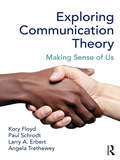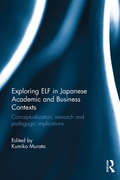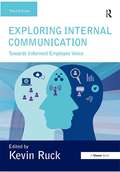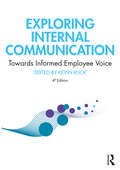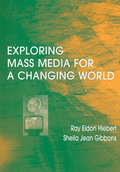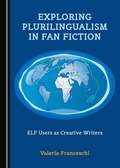- Table View
- List View
Exploring Communication Theory: Making Sense of Us
by Kory Floyd Paul Schrodt Larry Erbert Angela TretheweyThis text presents and explains theories from the epistemological perspectives of the researchers who use them. Rather than representing a specific theoretical paradigm (social scientific, interpretive, or critical), the author team presents the three major paradigms in one text, each writing in his or her area of expertise. Every theory is explained in a "native" voice, from a position of deep understanding and experience, improving clarity for readers. The text also provides insights on using communication theory to address real-life challenges. Considering that theories are developed to guide scholarly research more than to provide practical advice, this feature of the book helps students create realistic expectations for what theories can and cannot do and makes clear that many theories can have practical applications that students can use to their advantage in everyday life. Offering a comprehensive exploration of communication theories through multiple lenses, Exploring Communication Theory provides an integrated approach to studying communication theory and to demonstrating its application in the world of its readers.
Exploring Digital Humanities in India: Pedagogies, Practices, and Institutional Possibilities
by Maya Dodd Nidhi KalraThis book explores the emergence of digital humanities in the Indian context. It looks at how online and digital resources have transformed classroom and research practices. It examines some fundamental questions: What is digital humanities? Who is a digital humanist? What is its place in the Indian context? The chapters in the volume: • study the varied practices and pedagogies involved in incorporating the ‘digital’ into traditional classrooms; • showcase how researchers across disciplinary lines are expanding their scope of research, by adding a ‘digital’ component to update their curriculum to contemporary times; • highlight how this has also created opportunities for researchers to push the boundaries of their pedagogy and encouraged students to create ‘live projects’ with the aid of digital platforms; and • track changes in the language of research, documentation, archiving and reproduction as new conversations are opening up across Indian languages. A major intervention in the social sciences and humanities, this book will be of great interest to scholars and researchers of media studies, especially new and digital media, education, South Asian studies and cultural studies.
Exploring Digital Humanities in India: Pedagogies, Practices, and Institutional Possibilities
by Maya Dodd Nidhi KalraThis book explores the emergence of digital humanities in the Indian context. It looks at how online and digital resources have transformed classroom and research practices. It examines some fundamental questions: What is digital humanities? Who is a digital humanist? What is its place in the Indian context? The chapters in the volume: • study the varied practices and pedagogies involved in incorporating the ‘digital’ into traditional classrooms; • showcase how researchers across disciplinary lines are expanding their scope of research, by adding a ‘digital’ component to update their curriculum to contemporary times; • highlight how this has also created opportunities for researchers to push the boundaries of their pedagogy and encouraged students to create ‘live projects’ with the aid of digital platforms; and • track changes in the language of research, documentation, archiving and reproduction as new conversations are opening up across Indian languages. A major intervention in the social sciences and humanities, this book will be of great interest to scholars and researchers of media studies, especially new and digital media, education, South Asian studies and cultural studies.
Exploring ELF in Japanese Academic and Business Contexts: Conceptualisation, research and pedagogic implications
by Kumiko MurataThis book investigates the theoretical, empirical and pedagogical issues to help us better understand what is happening with English as a Lingua Franca (ELF) communication and to activate this knowledge in respective communicative contexts. It focuses specifically on Japanese contexts and also includes theoretical and practical sections pertinent to all ELF researchers, practitioners and students, irrespective of their national or regional differences. It further attempts to connect this new field of research to established fields of linguistics and applied linguistics such as communication, assessment and multilingualism by exploring them from an ELF perspective, which is challenging but essential for the development of the field. Exploring ELF in Japanese Academic and Business Contexts: Conceptualisation, research and pedagogic implications includes chapters about: English in a Global Context Own-language use in academic discourse English as a lingua franca in international business contexts A linguistic soundscape/landscape analysis of ELF information provision in public transport in Tokyo Using pragmatic strategies for effective ELF communication: Relevance to classroom practice This book will be of interest to scholars and post-graduate students working in the fields of Applied Linguistics/TESOL. It will also engage researchers studying the growing influence of English around the world.
Exploring ELF in Japanese Academic and Business Contexts: Conceptualisation, research and pedagogic implications
by Kumiko MurataThis book investigates the theoretical, empirical and pedagogical issues to help us better understand what is happening with English as a Lingua Franca (ELF) communication and to activate this knowledge in respective communicative contexts. It focuses specifically on Japanese contexts and also includes theoretical and practical sections pertinent to all ELF researchers, practitioners and students, irrespective of their national or regional differences. It further attempts to connect this new field of research to established fields of linguistics and applied linguistics such as communication, assessment and multilingualism by exploring them from an ELF perspective, which is challenging but essential for the development of the field. Exploring ELF in Japanese Academic and Business Contexts: Conceptualisation, research and pedagogic implications includes chapters about: English in a Global Context Own-language use in academic discourse English as a lingua franca in international business contexts A linguistic soundscape/landscape analysis of ELF information provision in public transport in Tokyo Using pragmatic strategies for effective ELF communication: Relevance to classroom practice This book will be of interest to scholars and post-graduate students working in the fields of Applied Linguistics/TESOL. It will also engage researchers studying the growing influence of English around the world.
Exploring Health Communication: Language in Action
by Kevin Harvey Nelya KoteykoRoutledge Introductions to Applied Linguistics is a series of introductory level textbooks covering the core topics in Applied Linguistics, primarily designed for those beginning postgraduate studies, or taking an introductory MA course as well as advanced undergraduates. Titles in the series are also ideal for language professionals returning to academic study. The books take an innovative ‘practice to theory’ approach, with a 'back-to-front' structure. This leads the reader from real-world problems and issues, through a discussion of intervention and how to engage with these concerns, before finally relating these practical issues to theoretical foundations. Additional features include tasks with commentaries, a glossary of key terms, and an annotated further reading section. Exploring Health Communication brings together many of the various linguistic strands in health communication, while maintaining an interdisciplinary focus on method and theory. It critically explores and discusses a number of underlying themes that constitute the broad field of health communication including spoken, written and electronic health communication. The rise of the internet has led to an explosion of interactive online health resources which have profoundly affected the way in which healthcare is delivered, and with this, have brought about changes in the relationship between provider and patient. This textbook uses examples of real life health language data throughout, in order to fully explore the topics covered. Exploring Health Communication is essential reading for postgraduate and upper undergraduate students of applied linguistics and health communication.
Exploring Health Communication: Language in Action
by Kevin Harvey Nelya KoteykoRoutledge Introductions to Applied Linguistics is a series of introductory level textbooks covering the core topics in Applied Linguistics, primarily designed for those beginning postgraduate studies, or taking an introductory MA course as well as advanced undergraduates. Titles in the series are also ideal for language professionals returning to academic study. The books take an innovative ‘practice to theory’ approach, with a 'back-to-front' structure. This leads the reader from real-world problems and issues, through a discussion of intervention and how to engage with these concerns, before finally relating these practical issues to theoretical foundations. Additional features include tasks with commentaries, a glossary of key terms, and an annotated further reading section. Exploring Health Communication brings together many of the various linguistic strands in health communication, while maintaining an interdisciplinary focus on method and theory. It critically explores and discusses a number of underlying themes that constitute the broad field of health communication including spoken, written and electronic health communication. The rise of the internet has led to an explosion of interactive online health resources which have profoundly affected the way in which healthcare is delivered, and with this, have brought about changes in the relationship between provider and patient. This textbook uses examples of real life health language data throughout, in order to fully explore the topics covered. Exploring Health Communication is essential reading for postgraduate and upper undergraduate students of applied linguistics and health communication.
Exploring Internal Communication: Towards Informed Employee Voice
by Kevin RuckThis third edition of Exploring Internal Communication includes new chapters on the history of internal communication, the evolution of employee engagement, the current state of practice, change communication, storytelling, research and measurement, an internal communication measurement dashboard, intranet management and internal social media. It argues that internal communication practice is about keeping employees informed and at the same time giving them a voice that is treated seriously. The book is both a companion for internal communication courses and an exploration of key concepts for a strategic approach to practice that underpins employee engagement.
Exploring Internal Communication: Towards Informed Employee Voice
by Kevin RuckThis third edition of Exploring Internal Communication includes new chapters on the history of internal communication, the evolution of employee engagement, the current state of practice, change communication, storytelling, research and measurement, an internal communication measurement dashboard, intranet management and internal social media. It argues that internal communication practice is about keeping employees informed and at the same time giving them a voice that is treated seriously. The book is both a companion for internal communication courses and an exploration of key concepts for a strategic approach to practice that underpins employee engagement.
Exploring Internal Communication: Towards Informed Employee Voice
by Kevin RuckExploring Internal Communication has long been the go-to publication for internal communication, public relations and human resources practitioners who want their practice to be grounded in research and guided by evidence-based advice. The new fourth edition has been comprehensively updated throughout to reflect the latest practices in internal communication. Notably, the use of social media within organisations is covered in recognition of the increasing integration of digital platforms such as Workplace by Facebook, Slack and Yammer. A greater understanding of the different communication roles played by line managers and senior managers is emerging, and this is explored to help those managers understand what is expected of them and how to succeed as they communicate within this changing environment. And, the demands of channel management are becoming increasingly complex; this edition helps practitioners negotiate this complexity. Enriched with models, tips and case studies, this book is an indispensable tool for both students and practitioners alike.
Exploring Internal Communication: Towards Informed Employee Voice
by Kevin RuckExploring Internal Communication has long been the go-to publication for internal communication, public relations and human resources practitioners who want their practice to be grounded in research and guided by evidence-based advice. The new fourth edition has been comprehensively updated throughout to reflect the latest practices in internal communication. Notably, the use of social media within organisations is covered in recognition of the increasing integration of digital platforms such as Workplace by Facebook, Slack and Yammer. A greater understanding of the different communication roles played by line managers and senior managers is emerging, and this is explored to help those managers understand what is expected of them and how to succeed as they communicate within this changing environment. And, the demands of channel management are becoming increasingly complex; this edition helps practitioners negotiate this complexity. Enriched with models, tips and case studies, this book is an indispensable tool for both students and practitioners alike.
Exploring Mass Media for A Changing World
by Ray A Hiebert Sheila GibbonsBeautifully written and class tested, Exploring Mass Media for a Changing World provides a comprehensive but modestly priced text around which instructors can develop a customized teaching package. Written for introductory courses, it covers essential information students need in order to understand the media, the mass communication process, and the role of media in society. It summarizes basic, generally agreed-upon principles, theories, significant historical events, and essential facts, but does so in a tightly written, readable style. Taken together, this information can be thought of as a minimum repertoire that all citizens of the "information age" need in order to become literate consumers and users of mass communication. Features include: *Historical Framework--For ease of comprehension, media processes and individual media are placed in historical context to show their technological evolution and the effects of those changes on society. *Organization--The first seven chapters deal with the evolution of communication theories and processes common to all media. The next five deal with specific media in the chronological order in which they became mass media. Chapters 13 and 14 introduce two non-media institutions (advertising and public relations) whose exploration is essential in order to understand how mass media functions in our society. Finally, chapter 15 returns to the theme of technological evolution and its effects on society with an in-depth discussion of the internet. *Flexibility--Because it is concise, affordable, and comprehensive, it can be used either as a stand-alone text in mass media courses or as part of an instructional package in courses where mass communication is one of several major units. *Themes--The following themes are introduced early and carried throughout: (a) the evolution of media technology and its effects on society, (b) the global and culture-bound characteristics of mass media, and (c) the need for media literacy in the 21st century. *Supplements--An accompanying instructor's manual begins with a chapter-length essay on teaching the mass media course then offers the following items for each chapter: topical outline and key vocabulary; key ideas to be emphasized and pitfalls to be avoided; discussion questions; objective and essay test items; and both print and nonprint resources for further study.
Exploring Mass Media for A Changing World: Instructor's Manual: Cases For Reflection And Action
by Ray A Hiebert Sheila GibbonsBeautifully written and class tested, Exploring Mass Media for a Changing World provides a comprehensive but modestly priced text around which instructors can develop a customized teaching package. Written for introductory courses, it covers essential information students need in order to understand the media, the mass communication process, and the role of media in society. It summarizes basic, generally agreed-upon principles, theories, significant historical events, and essential facts, but does so in a tightly written, readable style. Taken together, this information can be thought of as a minimum repertoire that all citizens of the "information age" need in order to become literate consumers and users of mass communication. Features include: *Historical Framework--For ease of comprehension, media processes and individual media are placed in historical context to show their technological evolution and the effects of those changes on society. *Organization--The first seven chapters deal with the evolution of communication theories and processes common to all media. The next five deal with specific media in the chronological order in which they became mass media. Chapters 13 and 14 introduce two non-media institutions (advertising and public relations) whose exploration is essential in order to understand how mass media functions in our society. Finally, chapter 15 returns to the theme of technological evolution and its effects on society with an in-depth discussion of the internet. *Flexibility--Because it is concise, affordable, and comprehensive, it can be used either as a stand-alone text in mass media courses or as part of an instructional package in courses where mass communication is one of several major units. *Themes--The following themes are introduced early and carried throughout: (a) the evolution of media technology and its effects on society, (b) the global and culture-bound characteristics of mass media, and (c) the need for media literacy in the 21st century. *Supplements--An accompanying instructor's manual begins with a chapter-length essay on teaching the mass media course then offers the following items for each chapter: topical outline and key vocabulary; key ideas to be emphasized and pitfalls to be avoided; discussion questions; objective and essay test items; and both print and nonprint resources for further study.
Exploring Plurilingualism in Fan Fiction: ELF Users as Creative Writers (PDF)
by Valeria FranceschiThis book explores English as a Lingua Franca (ELF) use in online interaction within virtual communities constituted by fans of popular culture texts who engage in creative writing inspired by such texts. Emerging from globalization processes, ELF, computer-mediated-communication, and fandom are here conceptualized as postmodern phenomena, characterized by fluidity, hybridity, and translocal practices, which include the exploitation of plurilingual resources on the part of non-native users communicating in English. This study adopts and applies the notions of linguistic heteroglossia and super-diversity to the qualitative analysis of a fan fiction corpus constituted of online-published stories inspired by Japanese media texts, in which fan writers bring their sociocultural and linguistic repertoires to bear on their stories, interspersing narration and dialogue with non-English language elements to fulfil social, narrative, and pragmatic functions.
Exploring Positive Relationships at Work: Building a Theoretical and Research Foundation (Organization and Management Series)
by Jane E. Dutton Belle Rose RaginsThis edited volume brings together a select group of leading organizational scholars for the purpose of developing a foundation-setting book on positive relationships at work. Positive Relationships at Work (PRW) is a rich new interdisciplinary domain of inquiry that focuses on the generative processes, relational mechanisms and outcomes associated with positive relationships between people at work. This volume builds a solid foundation for this promising new area of scholarly inquiry and offers a multidisciplinary exploration of how relationships at work become a source of growth, vitality, learning and generative states of human and collective flourishing. A unique feature of the book is the use of a connecting commentator chapter at the end of each section. The Commentator Chapters, written by preeminent scholars, uncover and discuss integrative themes that emerge within sections. The editors approach the topic from multiple levels, each level providing critical, valuable insights into the dynamic process underlying positive relationships at work. These levels are arranged in five parts: an introduction to positive relationships at work; Individuals and Dyads; Groups and Communities; Organizations and Organizing; and a conclusion that offers an engaging invitation and multi-level map for guiding future research. This volume will appeal to academics and practitioners, as well as scholars and graduate students in organizational psychology, management, human resources, and inter-personal communications.
Exploring Positive Relationships at Work: Building a Theoretical and Research Foundation (Organization and Management Series)
by Building A TheoreticalThis edited volume brings together a select group of leading organizational scholars for the purpose of developing a foundation-setting book on positive relationships at work. Positive Relationships at Work (PRW) is a rich new interdisciplinary domain of inquiry that focuses on the generative processes, relational mechanisms and outcomes associated with positive relationships between people at work. This volume builds a solid foundation for this promising new area of scholarly inquiry and offers a multidisciplinary exploration of how relationships at work become a source of growth, vitality, learning and generative states of human and collective flourishing. A unique feature of the book is the use of a connecting commentator chapter at the end of each section. The Commentator Chapters, written by preeminent scholars, uncover and discuss integrative themes that emerge within sections. The editors approach the topic from multiple levels, each level providing critical, valuable insights into the dynamic process underlying positive relationships at work. These levels are arranged in five parts: an introduction to positive relationships at work; Individuals and Dyads; Groups and Communities; Organizations and Organizing; and a conclusion that offers an engaging invitation and multi-level map for guiding future research. This volume will appeal to academics and practitioners, as well as scholars and graduate students in organizational psychology, management, human resources, and inter-personal communications.
Exploring Professional Communication: Language in Action
by Stephanie SchnurrRoutledge Introductions to Applied Linguistics is a series of introductory level textbooks covering the core topics in Applied Linguistics, primarily designed for those beginning postgraduate studies, or taking an introductory MA course as well as advanced undergraduates. Titles in the series are also ideal for language professionals returning to academic study. The books take an innovative ‘practice-to-theory’ approach, with a 'back-to-front' structure. This leads the reader from real-world problems and issues, through a discussion of intervention and how to engage with these concerns, before finally relating these practical issues to theoretical foundations. Additional features include tasks with commentaries, a glossary of key terms, and an annotated further reading section. Exploring Professional Communication provides an accessible overview of the vast field of communication in professional contexts from an applied linguistics perspective. It explores the nature of professional communication by discussing various fundamental topics relevant for an understanding of this area. The book is divided into eight chapters, each dealing with a specific area of professional communication, such as genres of professional communication, identities in the workplace, and key issues of gender, leadership and culture. Although the book’s main approach to professional communication is an applied linguistics one, it also draws on insights from a range of other disciplines. Throughout, Stephanie Schnurr takes an interactive approach that is reflected in the numerous examples of authentic discourse data, from a variety of written and spoken contexts. Exploring Professional Communication is critical reading for postgraduate and upper undergraduate students of applied linguistics and communication studies.
Exploring Professional Communication: Language in Action (Routledge Introductions to Applied Linguistics)
by Stephanie SchnurrRoutledge Introductions to Applied Linguistics is a series of introductory level textbooks covering the core topics in Applied Linguistics, primarily designed for those beginning postgraduate studies, or taking an introductory MA course as well as advanced undergraduates. Titles in the series are also ideal for language professionals returning to academic study. The books take an innovative ‘practice-to-theory’ approach, with a 'back-to-front' structure. This leads the reader from real-world problems and issues, through a discussion of intervention and how to engage with these concerns, before finally relating these practical issues to theoretical foundations. Additional features include tasks with commentaries, a glossary of key terms, and an annotated further reading section. Exploring Professional Communication provides an accessible overview of the vast field of communication in professional contexts from an applied linguistics perspective. It explores the nature of professional communication by discussing various fundamental topics relevant for an understanding of this area. The book is divided into eight chapters, each dealing with a specific area of professional communication, such as genres of professional communication, identities in the workplace, and key issues of gender, leadership and culture. Although the book’s main approach to professional communication is an applied linguistics one, it also draws on insights from a range of other disciplines. Throughout, Stephanie Schnurr takes an interactive approach that is reflected in the numerous examples of authentic discourse data, from a variety of written and spoken contexts. Exploring Professional Communication is critical reading for postgraduate and upper undergraduate students of applied linguistics and communication studies.
Exploring Public Relations: Global Strategic Communication (PDF)
by Ralph Tench Liz YeomansThis text is the definitive academic guide on public relations and one of the only texts on the market to take this particular approach to the field. It offers critical analysis of the subject, blended with theory and real-life application, making use of a number of pedagogical features including case studies, exercises and discussion questions for a unique approach to the subject.
Exploring Public Relations (3rd edition) (PDF)
by Ralph Tench Liz YeomansExploring Public Relations is the definitive academic text on Public Relations. Now in its third edition, the book is essential reading on courses in PR at undergraduate and postgraduate level. It continues to provide a critical analysis of the subject and a sophisticated blend of theory with real life, and includes many case studies, activity exercises, discussion questions and full colour photographs to illustrate the discussions in the text. There is new coverage of the impact of Web 2. 0 technologies on PR as well as updated case studies and examples throughout the book to engage students of this exciting subject with the thought processes behind some of the latest PR stunts.
Exploring the Implications of Complexity Thinking for Translation Studies (The IATIS Yearbook)
by Kobus MaraisExploring the Implications of Complexity Thinking for Translation Studies considers the new link between translation studies and complexity thinking. Edited by leading scholars in this emerging field, the collection builds on and expands work done in complexity thinking in translation studies over the past decade. In this volume, the contributors address a variety of implications that this new approach holds for key concepts in Translation Studies such as source vs. target texts, translational units, authorship, translatorship, for research topics including translation data, machine translation, communities of practice, and for research methods such as constraints and the emergence of trajectories. The various chapters provide valuable information as to how research methods informed by complexity thinking can be applied in translation studies. Presenting theoretical and methodological contributions as well as case studies, this volume is of interest to advanced students, academics, and researchers in translation and interpreting studies, literary studies, and related areas.
Exploring the Implications of Complexity Thinking for Translation Studies (The IATIS Yearbook)
by Kobus Marais Reine MeylaertsExploring the Implications of Complexity Thinking for Translation Studies considers the new link between translation studies and complexity thinking. Edited by leading scholars in this emerging field, the collection builds on and expands work done in complexity thinking in translation studies over the past decade. In this volume, the contributors address a variety of implications that this new approach holds for key concepts in Translation Studies such as source vs. target texts, translational units, authorship, translatorship, for research topics including translation data, machine translation, communities of practice, and for research methods such as constraints and the emergence of trajectories. The various chapters provide valuable information as to how research methods informed by complexity thinking can be applied in translation studies. Presenting theoretical and methodological contributions as well as case studies, this volume is of interest to advanced students, academics, and researchers in translation and interpreting studies, literary studies, and related areas.
Exploring the Limits: Europe’s Changing Communication Environment (European Communication Council Report)
by U. T. Lange European Communication European Communication Council (ECC) K. GoldhammerIn dem Statusreport des European Communication Council stehen wissenschaftliche Analysen mit den Schwerpunkten: die neuen Arbeitsplätze, die Auswirkungen der Regulierungsansätze sowie die Forderung eines eigenen europäischen Internets im Vordergrund. Der erstmaig erstellte Facts & Figures - Teil informiert über die neuesten Basisdaten der Kommunikationsindustrie. Die wichtigsten Thesen: Ein eigenes europäisches Internet ist notwendig, um die Online-Nutzung in Europa zu erleichtern und zu beschleunigen. Neue europäische Medien brauchen eigene europäische Anbieter, um die gesellschaftliche und kulturelle Vielfalt in Europa zu stärken. Die Telekommunikationsleistungen in Europa sind zu teuer. Der integrierte Ansatz der Fernseh- und Telekommunikationsregulierung in den USA kann auch ein Modell für Europa sein.
Exploring the Public Effects of Religious Communication on Politics
by Brian CalfanoThough not all people are religious believers, religion has played important historic roles in developing political systems, parties, and policies—affecting believers and nonbelievers alike. This is particularly true in the United States, where scholars have devoted considerable attention to a variety of political phenomena at the intersection of religious belief and identity, including social movements, voting behavior, public opinion, and public policy. These outcomes are motivated by “identity boundary-making” among the religiously affiliated. The contributors to this volume examine two main factors that influence religious identity: the communication of religious ideas and the perceptions of people (including elites) in communicating said ideas. Exploring the Public Effects of Religious Communication on Politics examines an array of religious communication phenomena. These include the media’s role in furthering religious narratives about minority groups, religious strategies that interest groups use to advance their appeal, the variable strength of Islamophobia in cross-national contexts, what qualifies as an “evangelical” identity, and clergy representation of religious and institutional teachings. The volume also provides ways for readers to think about developing new insights into the influence religious communication has on political outcomes.
Exploring the Rhetoric of International Professional Communication: An Agenda for Teachers and Researchers (Baywood's Technical Communications)
by Carl R. Lovitt Dixie GoswamiPresents a collection of fourteen essays that responds to the need for a more rhetorical conception of professional communication as an international discipline. This book challenges the adequacy of relying on preconceived notions about the factors that determine discourse in international professional settings.
